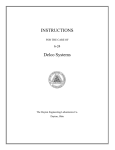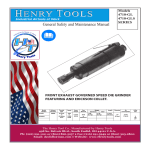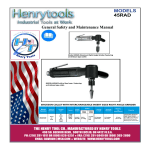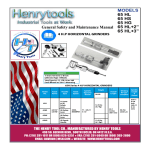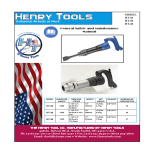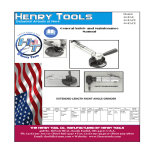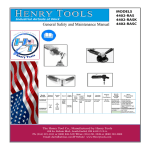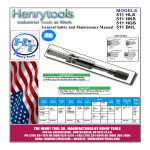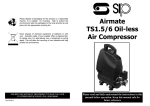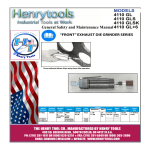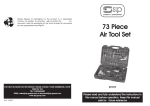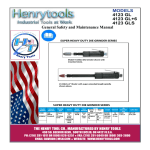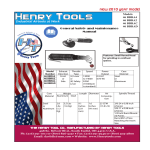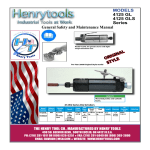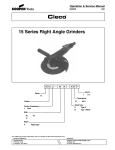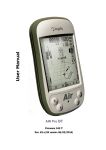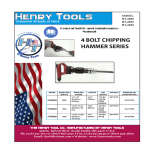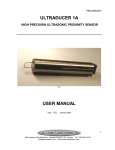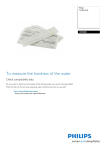Download Manual - Henry Tools
Transcript
H ENRY T OOLS Models 42-GHL Industrial Airtools at Work General Safety and Maintenance Manual Model Number 42-GHL Exhaust Direction Side Throttle Type (L) Lever or (K) Safety Lever Speed 1500022000 R.P.M. RatedPower Output 0.9 H.P .675 W Case Material Alum. Weight Aluminum Length Steel 2 1/2 lbs 1.1kg Alum case only 8 5/8” 219m Diameter Front Housing Air Consumption 1.50 Inch 25 cfm (38.1 (11.8 L/S) mm) Spindle Thread Type 3/8-24 X 1.0 Inch The Henry Tool Co., Manufactured by Henry Tools 498 So. Belvoir Blvd., South Euclid, OH 44121 U.S.A. Ph: (216) 291-1011 or (800) 826-5257 ● Fax: (216) 291-5949 or (800) 303-2800 Email: [email protected] ● Website: www.Henrytools.com General Operators Instructions and Service Manual Models 42-GHL Revised 12/12/09 www.HenryTools.com | Page 37 The Henry Tool Co., Manufactured by Henry Tools ALWAYS COMPLY WITH: 1. General Industry Safety & Health Regulations, Part 1910, OSHA 2206, available from: Sup’t of Documents; Government Printing Office; Washington DC 20402 2. Safety Code for Portable Air Tools, ANSI B186.1 available from: American National Standards Institute, Inc.; 1430 Broadway; New York, NY 10018 3. State and Local regulations. 4. Portions of the above codes and regulations are listed below for quick reference. THESE EXCERPTS ARE NOT INTENDED TO BE ALL INCLUSIVE STUDY AND COMPLY WITH ALL REGULATIONS! 1. Always turn off the air supply and disconnect the air supply hose before installing, removing or adjusting any accessory on this tool, or before performing any maintenance on this tool. 2. After mounting a wheel or other abrasive accessory, the Grinder shall be run in a protected enclosure, at gradually increasing speed, for at least 60 seconds. When starting work with a cold wheel, apply it gradually to the workpiece until it becomes warm. Do not continue to use a grinder if: • The speed rating of the accessory is less than the speed of the grinder • If tool vibrates repair immediately. • You sense changes in tool speed or an unusual increase in noise that would indicate tool is running at excessive speed. • You notice excessive end play in spindle • You hear any unusual sound from grinder RETURN THE TOOL TO THE TOOL CRIB FOR SERVICE IMMEDIATELY. 3. Make certain no one is in front of or in line with the wheel or other abrasive accessory. Be aware that it may fail at this time if it is defective, improperly mounted or the wrong size and speed. Stop immediately if considerable vibration or other defects are detected. Shut off the air supply and determine the cause. 4. OPERATOR PROTECTIVE EQUIPMENT - Wear goggles or face shield at all times tool is in operation. Other protective clothing shall be worn, if necessary. SEE REGULATIONS. 5. Keep hands, loose clothing and long hair away from rotating end of tool. 6. Anticipate and be alert for sudden changes in motion during start up and operation of any power tool. 7. Keep body stance balanced and firm. Do not overreach when operating this tool. High reaction torques can occur at or below the recommended air pressure. 8. Tool accessories may continue to rotate briefly after throttle is released. 9. Air powered tools can vibrate in use. Vibration, repetitive motions or uncomfortable positions may be harmful to your hands and arms. Stop using any tool if discomfort, tingling feeling or pain occurs. Seek medical advice before resuming use. 10. This tool is not designed for working in explosive atmospheres. Do not use this tool on materials whose dust or fumes can cause a potentially explosive environment. 11. 12. This tool is not insulated against electric shock. 13. Product Safety information - When Placing the Tool in Service • NEVER MODIFY ANY PART OF THIS TOOL!!!! Always install, operate, inspect and maintain this product in accordance with all applicable standards and regulations (local, state, country, federal, etc.). • Always use clean, dry air at 90 psig (6.2 bar/620 kPa) maximum air pressure at the inlet. Higher pressure may result in hazardous situations including excessive speed, rupture, or incorrect output torque or force. • Be sure all hoses and fittings are the correct size and are tightly secured. • Install a properly sized Safety Air Fuse upstream of hose 498 So. Belvoir Blvd., South Euclid, OH 44121 U.S.A. Ph: (216) 291-1011 or (800) 826-5257 ● Fax: (216) 291-5949 or (800) 303-2800 Email: [email protected] ● Website: www.Henrytools.com GRINDER SAFETY General Operators Instructions and Service Manual Models 42-GHL Part Number Description 320-9R O-Ring Part Number 320-9-W Wafer GUARDS 400-2-G (w/400-44) Cylinder(18000RPM STANDARD) 501-4A 4” Guard 400-2 Cylinder 15000RPM 412888 3” Guard (501-3A) 400-3 Rear Plate(Standard) 400-3A Rear Plate(15000RPM) 400-5 Rotor 400-6 Blade(5 are req’d) 400-7 Front Thrust 400-9 Rear Bearing (Sealed) (590004) 400-10 Key 400-27 Bushing 400-39 Lock Ring (844941) 400-44 Pin Collet Spacer 3/8” 400-77J 3/8” Threaded Spacer 400-G-42 Washer(2 Req’d) 400-G-47 3/8” Nut HT-1010 Heavy Duty Collet Assembly (1/4”) HT-1010-3/8 Heavy Duty Collet Assembly (3/8”) 1100-056 Wrench 9/16” 1100-100 Wrench 1” 1100-075 Wrench 3/4” 402-134 Muffler Screen 400-51 O-Rlng 400-G-1 Case (Alum.) (412431) 400-G-1-S Case (STEEL) 400-G-4 Alum.Coupling 400-G-4-S Steel Coupling 400-G-11 Bearing(2 Req’d) 400-G-17 Alum. Exhaust Sleeve 400-G-17-S Steel Exhaust Sleeve 400-G-26 Valve Lever 400-G-29 Valve (412451) 400-GH-1-3 Extended Case (Aluminum) 400-GH-14-3 Spindle (40GHL) (412477)Non-Govrned 500-G-44 Wheel Washers for 4” Wheels 500-G-42-A Flange, 1/2-20 Thread 500-16B Front Bearing CAP 500-21 Seal(Optional) 501-13 Bearings (412891)(PAIR) 700-37 Lever Pin 832636 T.V. Cap Gasket 869311 Throttle Valve Cap www.HenryTools.com | Page 38 • DO NOT MODIFY THE TOOL, SAFETY DEVICES, OR ACCESSORIES. • Use accessories recommended by Henry tools. • Do not use this tool if the actual free speed exceeds the rated rpm. Check the free speed of the Grinder before mounting a wheel, after all tool repairs, before each job and after every 8 hours of use. Check speed with a calibrated tachometer, without the abrasive product installed. • Do not use any wheel or other abrasive accessory whose maximum operating speed, as defined by its manufacturer, is less than the rated speed of the Grinder. • Inspect all grinding wheels for chips or cracks prior to mounting. Do not use a wheel that is chipped, cracked or otherwise damaged. • Inspect arbor, threads & clamping devices for damage & wear prior to mounting wheel or other abrasive accessory. • Do not use a grinding wheel that has been exposed to freezing temperatures, extreme temperature changes, high humidity, solvents, water or other liquids. • Make certain grinding wheel or other abrasive accessory properly fits the spindle. The wheel should not fit too snugly or too loosely. Plain hole wheels should have about .007” (0.17 mm) maximum diametral clearance. Do not use reducing bushings to adapt a wheel to any arbor unless such bushings are supplied by and recommended by the wheel manufacturer. • Always use the wheel flanges furnished by the manufacturer and appropriate for the wheel size and type. Never use a makeshift flange or plain washer. Flanges should be in good condition and free of nicks, burrs and sharp edges. • Ensure that the thread type and size of the threaded abrasive product exactly matches the thread type and size of the spindle. • Prevent the spindle end from touching the bottom of the hole of cups, cones or plugs with threaded holes, intended to be mounted on machine spindles, by comparing dimensions and other relevant data for them. • Do not use an unguarded grinder unless used for internal work and only operated when the work offers protection. Revised 12/12/09 The Henry Tool Co., Manufactured by Henry Tools 400-76-J-3/8” and use an anti-whip. • Always turn off the air supply, bleed the air pressure and disconnect the air supply hose before installing, removing or adjusting any accessory on this tool, or before performing any maintenance on this tool or any accessory. • Ensure that the grinding wheel or other abrasive accessory is correctly mounted and tightened before use. • Always replace a damaged, bent or severely worn wheel guard. Do not use a wheel guard that has been subjected to wheel failure. • • Guard opening must face away from the operator. Bottom of wheel must not project beyond guard. 498 So. Belvoir Blvd., South Euclid, OH 44121 U.S.A. Ph: (216) 291-1011 or (800) 826-5257 ● Fax: (216) 291-5949 or (800) 303-2800 Email: [email protected] ● Website: www.Henrytools.com ACCESSORIES Description General Operators Instructions and Service Manual Revised 12/12/09 run tool to allow oil to be carried to interior. DISASSEMBLY 1. Disconnect air supply and remove all wheels and accessories. 2. Clamp wrench flats of case(400-GH-1) in vise and unscrew backhead(400-G-4). Unscrew case (400-G-1) and remove it. Lift off exhause sleeve (400-G-17). 3. Remove snap ring(400-39) and(320-9R) and (320-9R). 4. Remove assembly from vise. Place brass jaws in vise. Clamp cylinder and rear thrust assembly in vise. Using a 3/16” punch, tap out lightly on the end of the spindle(400-GH-14-3). This will allow the cylinder(400-2[G]), end plate(400-3), bearing(400-9), and blades(400-6) to be removed. 5. Lightly grasp Cylinder(400-2G) and endplate (400-3) in vise. Using a 5/16”punch, tap out bearing(400-9) from end plate(400-3). Being careful not to drop the entire assembly on the floor after freeing the bearing. 6. Place rotor(400-5), whcih is stiill attached to the spindle, in a vise with brass jaws. Unscrew wheel flange(500-G-42A)(NOTE: right hand thread). Remove rotor, key(400-10), and front thrust plate(400-7). 7. Remove brass jaws from vise. Clamp wrench flats of case(400-G-1) in vise. Remove bearing cap(500-16B)(left hand thread). Using an arbor press, press on the front of the spindle. This will enable the rear bearing(400-G-11) to drop out and the spindle to be removed. 8. Using a 3/4” round bar, tap out bearing (501-13) from case (400-GH-1). REASSEMBLY 1. Press bearings (501-13) into recess in front of the case(400-GH-1-3). Spin (500-16B) back onto (400-GH-1)(NOTE: Left Hand Thread) a. Press spindle (400GH-14-3) through bearings from the rear. 2. Press bearing (400-G-11) into case from the rear and place the front thrust plate (400-7) over the bearing. 3. Place case (400-GH-1-3) in vise by the flats. Tighten bearing cap(500-16B)(Left hand thread). Make sure (500-16B) is tight. 4. Replace key(400-10) and drop rotor(400-5) into place. With BRASS jaws installed on vise, grab hold of rotor(400-5). Replace flange(500-G-42A) onto spindle (400-GH-14) and tighten. 5. Place cylinder (400-2G) over rotor (400-5). Place rear thrust (400-3) on cylinder(make sure pin in cylinder lines up with hole in rear plate(400-3). Press bearing(400-9) into rear thrust with a suitable bearing driver. 6. Place o-ring(320-9R), washer(320-9W) in rear thrust. Place snap ring(400-3) into groove. 7. Place O-ring (400-51) onto case(400-G-1). Place case(400-G-1) into sleeve (400-G-17). Slide this assembly onto case(400-GH-1) and hand tighten. 8. Optional Step: To make sure there are no air leaks in handle, unscrew cap (869311) and lift out spring(400-G-34)and throttle valve (400-G-29). Remove oring(400-G-31) with a sharp tool and replace with a new O-ring. www.HenryTools.com | Page 39 The Henry Tool Co., Manufactured by Henry Tools This tool is designed to operate on 90 psig(6.2 bar) maximum air pressure with 1/4”(8mm) hose. Do not use any wheel having an operating speed lower than the actual free speed on grinder. SAFETY 1. Check speed of tool with tachometer before every wheel & burr change. If RPM excees rated speed stamped on tool, servicing is required. 2. Inspect grinding wheels for bends, chips, nicks, cracks or severe wear. If the wheel has any of these, or has bee soaked in liquids do not use. On brushes check for loose wires that may fly off in operation. 3. Start new grinding wheels under a steel bench. Run at full throttle for one minute. Defective wheels usually come apart immediately. When starting a cold wheel apply to the work slowly, allow wheel to warm up gradually. Model 42GH grinders are equipped with a guard from the manufacturer. A guard is not needed for: a.) mounted wheels two inches (50 mm) or smaller; b.) grinders used for internal work, while within the work being ground. 4. At least one-half of the mandrel length (i.e. mounted wheel, burr, etc.)must be inserted into the collet. Secure collet chuck tightly. 5. Before mounting or removing a wheel or carbide burr disconnect grinder from air supply. The wheel should fit properly on arbor; do not use bushings or wheel flanges to adapt a wheel to any arbor unless recommended by manufacturer. (Wheel flanges should be at least 1/3 the diameter of the grinding wheel.) 6. Wear safety goggles and other protective clothing. Continuous exposure to vibration may cause injury to hands and arms. 7. Properly maintained air tools are less likely to fail or cause accidents. If tool vibrates unusually or produces an unusual noise, repair immediately. LUBRICATION Check for wet or dirty air. Excessive moisture in the air supply tends to wash lubricant away from the working parts of the tool and rust or corrode the interior. Grit will damage the interior by scoring closely fitted parts, and impede the action of the tool. If the above are found in order, disconnect tool and pour a liberal amount of recommended oil or an SAE #10 oil cut with an equal quantity of kerosene into the air inlet. Operate the tool to allow lubricant to flush accumulated gum and grit out the exhaust. If outside factors are not to blame, dissassemble the tool, clean and inspect all parts and replace those worn or broken. Coat parts with airtool oil and reassemble. Pour about 1/2 oz. in air inlet and 498 So. Belvoir Blvd., South Euclid, OH 44121 U.S.A. Ph: (216) 291-1011 or (800) 826-5257 ● Fax: (216) 291-5949 or (800) 303-2800 Email: [email protected] ● Website: www.Henrytools.com Models 42-GHL




